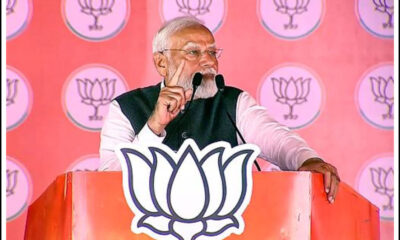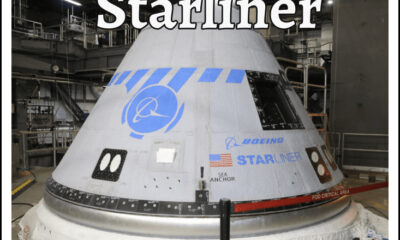Entertainment
Review of The Wonderful Story of Henry Sugar: Absolute And Pure Delight
Published
8 months agoon

Review of The Wonderful Story Of Henry Sugar: The movie is so exquisitely and sensitively made that it is difficult to describe as cinematic
New Delhi: In FI, the first of Wes Anderson’s four adaptations of lesser-known stories by Roald Dahl for Netflix, a painstaking miniaturist’s technique and a master raconteur’s unfettered imagination are harmonised with amazing perfection. The outcome is full and total joy.
One hesitates to use the word “cinematic” because the movie is so exquisitely and carefully put together. There is a lot more to it. It is an illustration and a celebration of the work that goes into creating, whether it is with language, colour, sound, image, or even just the power of the human mind. Anderson orchestrates a variety of threads that come together in The Wonderful Story of Henry Sugar while remaining distinct from one another.
Anderson’s debut stop-motion animation picture, which is among the best-known of the director’s productions, was inspired by Roald Dahl’s Fantastic Mr. Fox.
The writing and directing of Anderson, who brought The Wonderful Story of Henry Sugar to the big screen in all its splendour and more, subtly emphasise how planning for the process of creating a new work of art is just as significant as the actual production. The Wonderful Story’s intrinsic artifice is not in any way covered up or obscured. Instead, it is clearly defined and presented to us so that we may see, understand, and relish it.
Five actors—Ralph Fiennes, Benedict Cumberbatch, Dev Patel, Ben Kingsley, and Richard Ayoade—perform multiple roles, much like they might in a small theatre repertory. Additionally, they tell their personal stories while addressing the audience directly.
The Wonderful Story of Henry Sugar is, in some important ways, a continuation of Paul Thomas Anderson’s most recent two films, Asteroid City and The French Dispatch. He had journalists read their own tales to the audience in the latter, a bizarrely innovative movie that divided the critics.
Read also:-‘8th continent’ of the earth, Zealandia, is more precisely mapped by international experts
In Asteroid City, actors, writers, and theatre artists live and create a play-within-a-television-show-within-a-film in which the distinctions between the many storytelling formats are hazy.
The Wonderful Story of Henry Sugar movie begins with Ralph Fiennes’ portrayal of Roald Dahl sitting down to start writing. He is in what he calls his “writing hut” and adds, “I’ve been in this hut for 30 years now,” with his face partially turned away from the camera. What he says after that is likely a reflection of what Anderson does before beginning to shoot a new movie as a filmmaker: meticulously plan every last detail.
“Before I start writing,” the author explains in his working room, “I like to make sure I have everything I’m going to need around me.” Of course, cigarettes. Coffee and chocolates, please. And before I begin, I always make certain that I have a sharp pencil. I have six pencils… then I like to tidy my writing board… and ultimately, one begins…”
Anderson employs methods that are not only visible and energetic, but also complete what the picture is attempting to portray through the employment of live performers delivering lines at breakneck speed and the backdrops, many of which are painted, against which they are placed.
He uses animation and other ways to create a sense of fantasy – for example, when characters with yogic skills levitate, seats are painted to blend in with the background to create the illusion of a human floating several inches above the surface. Aside from that, stagehands move items in and out of the shots.
The author portrays the rich title character as a man who has “never worked a day in his life.” Then, Henry Sugar (Benedict Cumberbatch) introduces us to Dr. Z.Z. Chatterjee (Dev Patel), who is sitting in a friend’s well-stocked library reading a small blue exercise book.
Dr. Chatterjee introduces us to Imdad Khan (Ben Kingsley), “the man who can see without eyes,” while seated in the waiting area of a Calcutta hospital in 1935. The doctor is irate when Imdad enters the room through the door. He apologises but maintains his position. He has a point to make.
The doctor and his assistant, Dr. Marshall (Richard Ayouade), glue the man’s eyelids shut, fill his eyeballs with dough, and bandage his head and face to see if Imdad Khan can indeed perform the tasks he claims he can.
Imdad Khan is unstoppable because he has perfect vision. He now has the opportunity to tell the audience about a Great Yogi (Ayouade once more) whose capacity for concentration was so great that he was able to see without the use of his eyes. Imdad practises doing the same, and his tale—which is told word-for-word in Dr. Chatterjee’s brief book—gives Henry Sugar a thought.
Henry doesn’t do well at gambling, but he recognises the potential of the ability to interpret cards that have been turned over. He might find enormous success in the 10 London casinos he frequents thanks to it. However, it is a skill that is difficult to learn, and even once it is, there will be a cost.
Even the description “he said” and “I said” are practically verbatim reproduced in Dahl’s language in The Wonderful Story of Henry Sugar. The beauty of the visuals is wed to the purity of the written language. The overall product is a wonderful synthesis of art and artifice, both of which have real, measurable dimensions.
Henry Sugar, who discloses that this is not his real name and insists that it cannot be revealed, is confident that the narrative in which he is involved is authentic. He claims that if this were a fictional story as opposed to a factual one, it would have been required to create an unexpected and thrilling conclusion… something dramatic and distinctive… This account is true… Since it’s a genuine story, the conclusion must be accurate.
Yes, it does. In these 39 minutes of pure genius from Wes Anderson, everything rings true. The Wonderful Story of Henry Sugar’s marvellous, delicately adorned fusion of its perceptible physical and spatial dimensions with the ability of words, gestures, and guises to spark the imagination is what gives it such beauty. Isn’t it what all great films and tales are about?
By all accounts, The Wonderful Story of Henry Sugar is a fantastic dramatisation of a remarkable tale.
Cast:
Benedict Cumberbatch, Ralph Fiennes, and Dev Patel
Director:
Anderson, Wes
You may like
-


On the Citizenship Amendment Act (CAA), PM Narendra Modi challenges Congress and the SP
-


Shortly After Slovak PM’s Assassination, As Crowd Held Gunman
-


Vladimir Putin, the leader of Russia, makes a state visit to China as a symbol of the alliances’ solidarity
-


NASA: Bright, tiny, plant-like creatures discovered in the Celtic Sea
-


Earth’s North Pole is moving more quickly
-


Following the helium leak, Starliner is now aiming for a May 21 launch.

